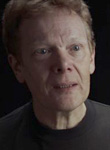High-wire artist Philippe Petit: Nothing is impossible
By Michelle Spektor

Passion. Tenacity. Intuition. Practice! Faith. Simplicity. Elegance. Surprise! Believe! Self-confidence.
These words, written on a white board Dec. 1 in Statler Auditorium by Philippe Petit -- high-wire artist, magician, juggler, unicycler, bullfighter, builder, visual artist and author -- describe his journey, he said, toward becoming a "poet of the air" and achieving the impossible in his art.
The meaning of these words for everyone, said Petit, who is best known for illegally walking between the roofs of Manhattan's Twin Towers on a high wire in 1974 -- the subject of the 2008 Academy Award-winning documentary "Man on Wire, " is for life itself. "You could call it courage, but I think it's life," he said. "For anybody, it's the life we should live."
Titled "Nothing Is Impossible," the talk by the 62-year-old French-born artist was sponsored by the Lawrence and Judith Tanenbaum Lecture Series of Sigma Phi.

Petit said that he developed an interest in magic and juggling as a young child and walked a high wire for the first time at age 16. Early on, he set his sights on achieving several "impossible" high-wire feats. These aspirations led him to illegally conduct high-wire performances at such international landmarks as the Notre Dame Cathedral in Paris and the Sydney Harbour Bridge in Sydney, Australia.
Petit recounted how high-wire performances can also create a public space for unity. In 1987, the mayor of Jerusalem invited Petit to walk a wire between the city's Jewish and Arab quarters for that year's Israel Festival. The performance amassed a crowd of 50,000 people from all parts of the city.
"This was a very important memory for me," said Petit. "That's what the wire can do, when you link two mountains, you link the people who live on those mountains."
In addition to showing slides and discussing several of his high-profile performances, Petit used a motley collection of props -- including a deck of cards, a Swiss army knife, a miniature ladder, a replica of an Easter Island moai statue and a long-stemmed rose -- to perform and explain various magic tricks. He showed how to move objects with a single red string, explained a disappearing card trick and balanced the rose on his face. He also cajoled the audience to laugh hysterically with him on the count of three.
"I find that life -- because I love life -- is full of surprises, and it's very important to surprise yourself," said Petit, as he encouraged the audience to approach day-to-day routines in new ways. "I want everybody, tonight, to brush your teeth with your other hand."
He also encouraged the audience to never dismiss anything as impossible. "If you are in the valley of life, and you see a giant slab of granite blocking your path, instead of running away, if you approach, you will very often find a fissure," said Petit. "It's a matter of finding the fissure, enlarging the hole and penetrating, and then you have the impossible behind you."
Michelle Spektor '12 is a writer intern for the Cornell Chronicle.
Get Cornell news delivered right to your inbox.
Subscribe